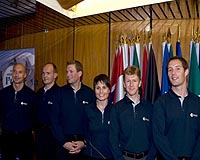 |
Cleveland OH (SPX) May 28, 2009 The first flight test of NASA's new rocket configuration to carry astronauts into space will take place later this year. Ares I-X consists of a four-segment first stage solid rocket motor, and a simulated upper stage that represents the weight and shape of the Ares I rocket and Orion crew vehicle. It will be launched in a suborbital arc into the Atlantic to collect data on its flight dynamics and parachute recovery performance. The flight of the unpiloted Ares I-X will be an important step in confirming that the rocket design is safe and stable in flight before piloted flights of Ares I begin in the middle of the next decade. But - even before the launch of Ares I-X - a critical series of ground tests will take place to confirm that the vehicle's dynamic response will respond to launch loads and vibrations the way that computer analytical models have predicted it will respond. "While we are confident in the predicted model results and simulations, these ground tests are critical because we have no experience launching rockets as long and slender as Ares I-X," according to Paul Bartolotta, Ares I-X Modal Test Lead who is responsible for leading a NASA-wide Modal Test Team from his office at NASA's Glenn Research Center, Cleveland, Ohio. The test series is a joint effort between NASA Glenn; NASA's Langley Research Center, Hampton, Va.; NASA's Marshall Space Flight Center, Huntsville, Ala.; and NASA's Kennedy Space Center, Fla. At approximately 14 feet in average diameter and 320 feet long, Ares I-X has a high "slenderness ratio" compared to other launch vehicles. The similarly-shaped Delta IV, for instance, is about 17 feet in average diameter and 225 feet long. The Saturn V was about 33 feet in average diameter and 363 feet in length. Due to its long slender shape, the Ares I-X is unique from a flight dynamics standpoint. "We're going to be shaking the vehicle to make sure our structural models match the actual vehicle characteristics," said Kurt Detweiler, Ares I-X Lead Systems Engineer, based at NASA Langley. "This is important for determining how the vehicle will respond during flight. If the vehicle doesn't match the analytical model, its guidance, navigation and control systems will be off," he added. This "modal testing," which refers to measuring a target set of bending modes, will include two partial stack tests and a test of the full Ares I-X vehicle on the Mobile Launch Platform, all in the Vehicle Assembly Building at Kennedy. The modal tests are a planned part of the build-up and integration of the Ares I-X test vehicle. In the first partial test, the topmost segments of the Ares I-X rocket - which will simulate the launch abort tower, crew module, service module and spacecraft adaptor - will be stacked vertically on a heavyweight spacecraft transportation cart. Two electro- mechanical shakers will be attached at the joint between the service module (which will house the second stage motor in the fully functional rocket) and the spacecraft adaptor (which will connect the uppermost segments to the rest of the rocket). The second partial stack test consists of the interstage, frustum, and the simulated fifth segment of the first stage of the rocket. After all rocket elements are stacked, but prior to roll out, the Ares I-X full stack test will be conducted to validate yet more bending modes and interactions between rocket elements. A series of sensors strategically located throughout the stacks will measure the amount and direction of movement, as the shakers impose random loads to determine the rocket segment's first several bending modes. A comparison will be made between predicted and measured mode shapes to verify the Ares I-X flight dynamics model. Share This Article With Planet Earth
Related Links Langley Research Center Glenn Research Center Space Tourism, Space Transport and Space Exploration News
 ESA Recruits New Class Of European Astronauts
ESA Recruits New Class Of European AstronautsParis, France (ESA) May 21, 2009 ESA has presented the six individuals who will become Europe's new astronauts. The new recruits will join the European Astronaut Corps and start their training to prepare for future missions to the International Space Station, and beyond. The new astronauts are:1. Samantha Cristoforetti, Italian 2. Alexander Gerst, German 3. Andreas Mogensen, Danish 4. Luca Parmitano, Italian ... read more |
|
| The content herein, unless otherwise known to be public domain, are Copyright 1995-2009 - SpaceDaily. AFP and UPI Wire Stories are copyright Agence France-Presse and United Press International. ESA Portal Reports are copyright European Space Agency. All NASA sourced material is public domain. Additional copyrights may apply in whole or part to other bona fide parties. Advertising does not imply endorsement,agreement or approval of any opinions, statements or information provided by SpaceDaily on any Web page published or hosted by SpaceDaily. Privacy Statement |